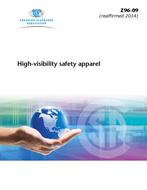CSA Z96-09 (R2014)
Click here to purchase
Preface
This is the second edition of CSA Z96, High-visibility safety apparel. It supersedes the previous edition published in 2002, and is based on the identically titled American National Standards Institute Standard ANSI/ISEA 107. It is also designed to be in harmony with CEN EN 471.
Scope
1.1
This Standard specifies requirements for occupational apparel that is
(a) capable of signalling the user’s presence visually; and
(b) intended to provide the user with conspicuity in hazardous situations under any light conditions and under illumination by vehicle headlights.
1.2
Performance requirements are included for colour, retroreflection, and minimum areas, as well as for the configuration of the materials. Performance requirements are also provided for the physical properties of background materials used in the construction of high-visibility safety apparel (referred to as “HVSA” in this Standard). Test methods are provided in the Standard to ensure that a minimum level of visibility is maintained when garments are subjected to ongoing care procedures.
1.3
This Standard provides performance requirements for conspicuous materials to be used in HVSA and specifies classes of garments, minimum areas, and placement of these materials.Note: Conspicuity is enhanced by high contrast between clothing and the work environment against which it is seen.
1.4
This Standard specifies minimum amounts of retroreflective materials, together with colour and requirements for placement of materials, for apparel used to enhance the visibility and safety of workers.Categories of high-visibility garments are identified and appropriate markings for apparel are recommended.
1.5
In CSA Standards, “shall” is used to express a requirement, i.e., a provision that the user is obliged to satisfy in order to comply with the standard; “should” is used to express a recommendation or that which is advised but not required; “may” is used to express an option or that which is permissible within the limits of the standard; and “can” is used to express possibility or capability. Notes accompanying clauses do not include requirements or alternative requirements; the purpose of a note accompanying a clause is to separate from the text explanatory or informative material. Notes to tables and figures are considered part of the table or figure and may be written as requirements. Annexes are designated normative (mandatory) or informative (non-mandatory) to define their application.
Product Details
- Edition:
- 2nd
- Published:
- 05/01/2009
- ISBN(s):
- 9781554911127
- Number of Pages:
- 52
- File Size:
- 1 file , 1.6 MB
- Product Code(s):
- 2419740, 2420282, 2020546
